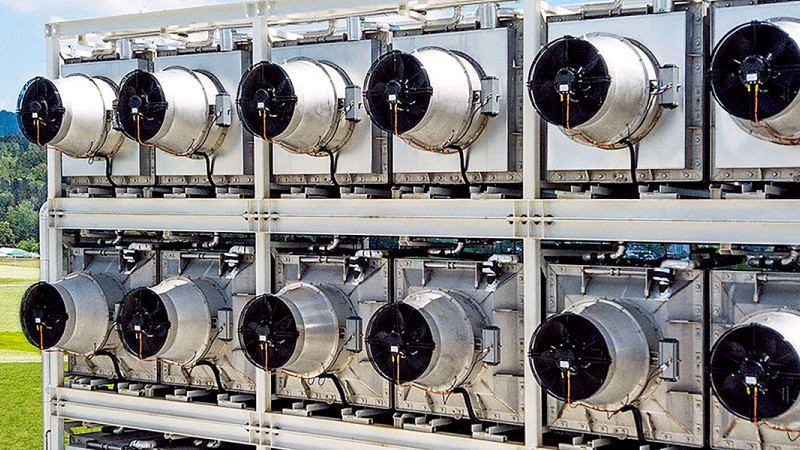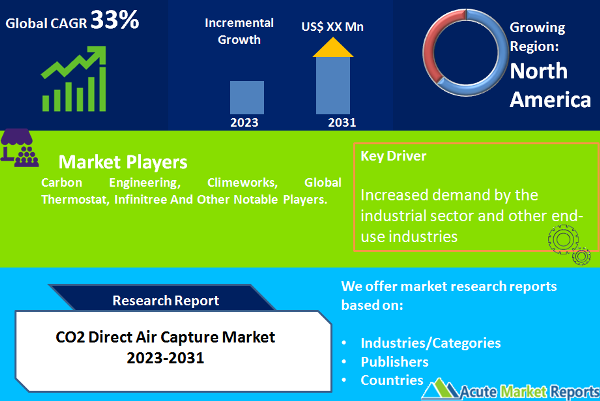
The global CO2 direct air capture market is expected to witness significant growth during the forecast period from 2025 to 2033. This growth can be attributed to the increasing concerns regarding greenhouse gas emissions and the rising demand for sustainable technologies to mitigate the effects of climate change. The market revenue for CO2 direct air capture is expected to grow at a CAGR of 33% during the forecast period of 2025 to 2033. CO2 direct air capture involves the capture of carbon dioxide directly from the air using various technologies and processes. The captured carbon dioxide can be utilized for various applications, including enhanced oil recovery, production of synthetic fuels and chemicals, and carbon sequestration. The growing demand for these applications is expected to drive the growth of the CO2 direct air capture market during the forecast period. The increasing investment in research and development activities for the development of new technologies and the commercialization of existing ones is expected to drive the growth of the CO2 direct air capture market. The deployment of pilot projects and demonstration facilities across various regions is also expected to contribute to the growth of the market during the forecast period. Moreover, the growing adoption of government policies and regulations aimed at reducing greenhouse gas emissions is expected to create significant opportunities for the growth of the CO2 direct air capture market. For instance, in 2020, the European Union introduced the EU Climate Law, which aims to reduce net greenhouse gas emissions by at least 55% by 2033. Such initiatives are expected to drive the demand for CO2 direct air capture technologies in the region.

Increasing Global Concerns Over Greenhouse Gas Emissions
The rising levels of greenhouse gas emissions have resulted in various environmental problems, including climate change, which have raised significant concerns globally. This has led to a surge in demand for technologies that can effectively mitigate the effects of climate change, such as CO2 direct air capture. For instance, the United Nations Framework Convention on Climate Change (UNFCCC) has been established to address global climate change issues, and several international agreements have been signed to reduce greenhouse gas emissions. This increasing global concern over greenhouse gas emissions is expected to drive the growth of the CO2 direct air capture market.
Advancements in Direct Air Capture Technologies
The development of new and advanced technologies for CO2 direct air capture has significantly increased over the years, resulting in the creation of more efficient and cost-effective solutions. For instance, in 2019, a Swiss company, Climeworks, announced the construction of the world's largest direct air capture plant that would capture 4,000 metric tons of CO2 annually. The increasing adoption of advanced CO2 direct air capture technologies is expected to drive the growth of the market.
Growing Government Support and Investments
Several governments across the world are taking initiatives to reduce greenhouse gas emissions and promote the use of clean energy sources. Governments are providing funding and support for the development and deployment of CO2 direct air capture technologies. For instance, the Canadian government has committed CAD 100 million for the development of direct air capture technologies. Such initiatives are expected to drive the growth of the CO2 direct air capture market.
High Cost of CO2 Direct Air Capture Technologies
One of the major restraints hindering the growth of the CO2 direct air capture market is the high cost of implementing and operating CO2 direct air capture technologies. The cost of capturing and storing carbon dioxide from the air is relatively higher than that of capturing it from industrial processes. Moreover, the current scale of CO2 direct air capture technology is limited, and the cost per metric ton of carbon dioxide removed is significantly higher than that of traditional carbon capture and storage methods. For instance, Climeworks, one of the leading direct air capture technology companies, charges about USD 600 per metric ton of CO2 removed, which is relatively higher than the current market price of carbon credits. The high cost of CO2 direct air capture technologies poses a significant challenge to the widespread adoption and growth of the market. However, technological advancements and supportive government policies are expected to drive down the cost of direct air capture technologies, thereby enabling wider adoption in the future.
Physical Absorption in Liquid Media Leading the Revenues for Market by Type
The CO2 direct air capture market can be segmented into two types: physical absorption in liquid media and absorption in solid media. Physical absorption in liquid media involves the use of solvents such as amines to capture carbon dioxide from the air. This technology is considered the most mature among direct air capture technologies and has been deployed commercially. Absorption in solid media involves the use of solid sorbents to capture carbon dioxide, which is regenerated at high temperatures to release the captured carbon dioxide. The solid sorbents used for carbon dioxide capture include metal-organic frameworks (MOFs), zeolites, and activated carbon. The absorption in the solid media type segment is expected to witness the highest CAGR over the forecast period of 2025 to 2033, due to the increasing research and development activities in this area. On the other hand, physical absorption in liquid media held the largest revenue share of the CO2 direct air capture market in 2024, owing to the commercial deployment of this technology. The technology is used in several large-scale direct air captures projects, such as Climeworks and Carbon Engineering. Overall, both physical absorption in liquid media and absorption in solid media is expected to witness significant growth opportunities in the CO2 direct air capture market.
Energy Fuel Segment Leading the Revenues for Market by Application
The CO2 direct air capture market can be segmented by application into four categories: food and beverage, greenhouse, energy fuel, and others. The energy fuel segment held the largest revenue share of the market in 2024 due to the increasing demand for sustainable fuels and the need to reduce carbon emissions. The direct air capture of carbon dioxide can provide a sustainable source of carbon for the production of fuels, thereby reducing reliance on fossil fuels. The food and beverage segment is expected to witness the highest CAGR over the forecast period of 2025 to 2033, due to the increasing demand for carbon-neutral food and beverage products. Direct air capture of carbon dioxide can be used in the production of carbonated beverages, thereby reducing the carbon footprint of the food and beverage industry. The greenhouse segment is also expected to witness significant growth opportunities due to the increasing demand for carbon-neutral agriculture practices. Direct air capture of carbon dioxide can be used to provide a source of carbon for greenhouses, thereby reducing reliance on fossil fuel-based sources of carbon. Overall, the CO2 direct air capture market has significant growth potential across all application segments due to the increasing demand for sustainable solutions to reduce carbon emissions.
North America Leading the Revenues, While Europe to Lead the Growth
North America held the largest revenue share of the market in 2024, due to the increasing adoption of sustainable solutions to reduce carbon emissions and the presence of several direct air capture companies in the region, such as Carbon Engineering and Climeworks. The region is also witnessing significant investments in the development of direct air capture technologies, which is further driving the growth of the market. Europe is expected to witness the highest CAGR over the forecast period of 2025 to 2033, due to the increasing investments in the development of direct air capture projects and the presence of several startups and research institutes focused on direct air capture technologies. The region has set ambitious targets to reduce carbon emissions, and direct air capture is seen as a key technology to achieve these targets. Asia Pacific is also expected to witness significant growth opportunities due to the increasing investments in the development of direct air capture projects in countries such as China, Japan, and South Korea. These countries have set ambitious targets to reduce carbon emissions and are investing in the development of direct air capture technologies to achieve these targets. Middle East and Africa and Latin America are expected to witness moderate growth opportunities in the CO2 direct air capture market due to the increasing investments in sustainable solutions to reduce carbon emissions. Overall, the CO2 direct air capture market has significant growth potential across all geographic segments due to the increasing demand for sustainable solutions to reduce carbon emissions.
Market to Remain Consolidated During the Forecast Period
The CO2 direct air capture market is highly competitive, with several players operating in the market. The market is dominated by a few major players such as Carbon Engineering, Climeworks, Global Thermostat, and Infinitree, among others. These players are investing in the development of innovative and cost-effective direct air capture technologies to reduce carbon emissions and address climate change. They are also focusing on partnerships and collaborations with other players in the market to expand their reach and increase their market share. For instance, Carbon Engineering has partnered with several companies such as Chevron, BHP, and Oxy Low Carbon Ventures to develop and commercialize direct air capture technologies. Key players in the CO2 direct air capture market are also investing in research and development to improve the efficiency and cost-effectiveness of direct air capture technologies. For instance, Climeworks is investing in the development of a new direct air capture plant that will use renewable energy sources such as solar power to reduce its energy costs and improve its efficiency. Another key strategy adopted by players in the CO2 direct air capture market is the diversification of their product offerings. Players are expanding their product portfolios to include carbon capture and storage (CCS) technologies and other sustainable solutions to address climate change. For instance, Global Thermostat has developed a proprietary CCS technology that can capture carbon dioxide emissions from industrial processes and convert them into valuable products such as fertilizers and building materials.
Historical & Forecast Period
This study report represents analysis of each segment from 2023 to 2033 considering 2024 as the base year. Compounded Annual Growth Rate (CAGR) for each of the respective segments estimated for the forecast period of 2025 to 2033.
The current report comprises of quantitative market estimations for each micro market for every geographical region and qualitative market analysis such as micro and macro environment analysis, market trends, competitive intelligence, segment analysis, porters five force model, top winning strategies, top investment markets, emerging trends and technological analysis, case studies, strategic conclusions and recommendations and other key market insights.
Research Methodology
The complete research study was conducted in three phases, namely: secondary research, primary research, and expert panel review. key data point that enables the estimation of CO2 Direct Air Capture market are as follows:
Market forecast was performed through proprietary software that analyzes various qualitative and quantitative factors. Growth rate and CAGR were estimated through intensive secondary and primary research. Data triangulation across various data points provides accuracy across various analyzed market segments in the report. Application of both top down and bottom-up approach for validation of market estimation assures logical, methodical and mathematical consistency of the quantitative data.
| ATTRIBUTE | DETAILS |
|---|---|
| Research Period | 2023-2033 |
| Base Year | 2024 |
| Forecast Period | 2025-2033 |
| Historical Year | 2023 |
| Unit | USD Million |
| Segmentation | |
Type
| |
Application
| |
|
Region Segment (2023-2033; US$ Million)
|
Key questions answered in this report